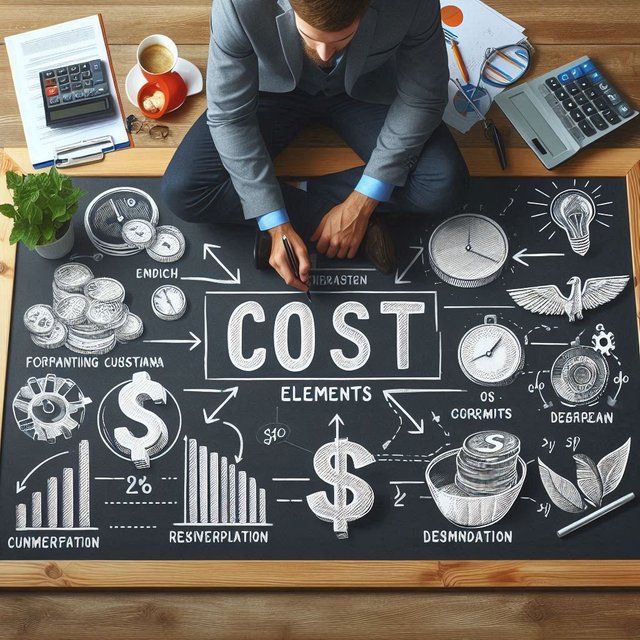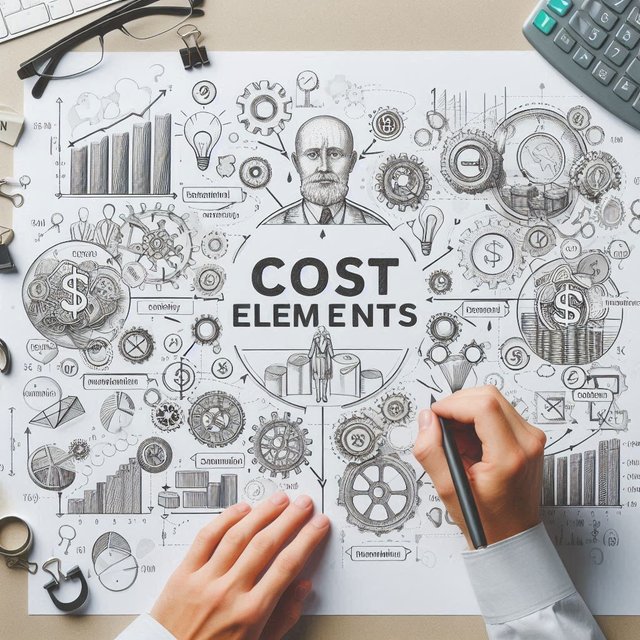SLC | S21W2 | Costs for entrepreneurs - Cost elements
Hello 🤗 guys,
I welcome you all to the Steemit Learning Challenge season 21 week 2 on a contest organised by @yolvijrm & @adeljose which talks about Costs for entrepreneurs - Cost elements. I'm going to be sharing my understanding on the said topic below as I try to attempt all the questions below.
| What is the relationship between costs and financial accounting? |
|---|
The relationship between costs and financial accounting can never be overemphasized or looked down up because financial accounting deals with records, report and analysis of cost and other elements in a business. So a few of the relationship are seen below for your information and better understanding.
Cost Recording and Classification: In every business, even as explained in the lecture you will agree with me that cost are classified into different types and for a better approach and good record this cost are recorded using financial accounting where we sort out the different types of cost incurred such as the direct cost, indirect cost etc.
With a proper classification you can be able to determine the entire cost of a production and where it is necessary to add money to your product such that you will not run in a lose and still maintain your customers.
Impact on Financial Statements: Another relationship between cost and financial accounting is seen in the financial statements. As you know, we have among other statements, income statement, balance sheet and cash flow statement. In all of these, financial accounting categories the different cost that fall under them and then give a clear report on them.
Cost Analysis for Financial Decision-Making: With the help of financial accounting which present all cost in a clear and concise manner, the analysis of the production is made easily and management of the business check if the business is in profit or not and also an informed decision is made thereafter to help ensure that profit in the business is made based on the said analysis.
Regulatory and Tax Compliance: Financial accounting also helps in the record of all forms of cost including the one associated with tax regulations and compliance. The essence of this record is so that anytime it is checked the accurate report should be obtained to avoid double payment.
| Establish the difference between fixed costs and variable costs, providing examples of each. |
|---|
Based on the name fixed and variable cost, you will agree with me that these two cost differ and I will be explaining them one after the other and also include their various example and still have a tabular form of these cost for your better understanding.
Fixed Costs
As the name suggests, fixed costs, these are the types of cost that remain unchanged or remain constant no matter what happens in the production sector. This means that despite the production or sales which the company makes at any point and time the cost remain thesame.
Example of Fixed Costs can include among others Rent or lease payments, Salaries, Insurance premiums, Depreciation, Loan payments, etc.
Variable Costs
As the name implies variable which means it is not constant it changes due to the level of production. This type of cost fluctuate and doesn't remain thesame. Since this cost depends on the level of production, when the amount of production goes high, the variable cost also increases and when the level of production goes low the variable cost also goes low.
Examples of Variable Costs can include Raw materials, Direct labor costs, Utilities, Sales commissions, Packaging and shipping etc.
| Fixed Cost | Variable Cost |
|---|---|
| Cost here is constant despite the production | Cost changes with production |
| Higher or lower productions incure same cost | Higher production incure higher cost, lower productions incure lower cost |
| Rent or lease payments, Salaries, Insurance premiums, Depreciation, Loan payments, etc are example here | Raw materials, Direct labor costs, Utilities, Sales commissions, Packaging and shipping etc. are example here |
| In a real or fictional case, identify the cost elements in manufacturing a product or providing a service. |
|---|
Let's consider the cost of manufacturing a sachet water. I call this sachet water Aqua Rapha (Fictional).
Direct Costs
Raw Materials ( Water, sachets, Sealing material )
Labor ( Production line workers, Quality control staff, Supervisors )
Indirect Cost
Overhead (Factory rent and utilities, Equipment maintenance and depreciation, Insurance )
Equipment (Sachet machines, Conveyors, Packaging machines)
Administrative and Selling Costs
Transportation, Marketing & Advertising, Miscellaneous
Example Application
With this breakdown of cost, a production firm who wants to go into sachet water Aqua Rapha will have a good idea and then make an informed decision after all the cost to determine how much each sachet water can be sold based on the incurred price. Also if there is a need for an alternative pricing which will reduce cost of production then it will be applied as well so that your product will stand out and also won't be too much high for anyone to purchase.
| The company Steemians manufactures a single product. During a given period, the following costs were incurred: |
|---|
| Concept | Cost |
|---|---|
| Direct raw material | 130 |
| Direct labor | 100 |
| Manufacturing Supplies | 210 |
| Delivery costs | 70 |
| Sales Commissions | 65 |
| Depreciation of plant and machinery | 25 |
| Plant Manager | 65 |
| Taxes and plant insurance | 70 |
| Sales and administrative expenses | 80 |
| Building maintenance | 50 |
| Public services | 35 |
| Maintenance of distribution equipment | 65 |
| Advertising | 20 |
You are asked to separate direct costs from indirect costs and non-manufacturing costs, and also calculate the total direct and indirect manufacturing costs.
From the data above, I will firstly classify these costs accordingly before putting it in tabular form then calculate their total as requested by the question.
Direct Costs
From the table above the cost that are seen as direct cost since they are directly associated to the production include
- Direct Raw Material
- Direct Labor
Indirect Costs
From the table above the cost that are seen as indirect cost since as they are associated not directly to production include
- Manufacturing Supplies
- Depreciation of Plant and Machinery
- Plant Manager
- Taxes and Plant Insurance
- Building Maintenance
- Public Services
Non-Manufacturing Costs
From the table above the cost that are seen as non-manufacturing cost because they are associated with selling, distribution etc but not production include
- Delivery Costs
- Sales Commissions
- Sales and Administrative Expenses
- Maintenance of Distribution Equipment
- Advertising
| Concept | Cost |
|---|---|
| DIRECT COST | |
| Direct Raw Material | 130 |
| Direct Labor | 100 |
| Total Direct Cost | 230 |
| INDIRECT COST | |
| Manufacturing Supplies | 210 |
| Depreciation of Plant and Machinery | 25 |
| Plant Manager | 65 |
| Taxes and Plant Insurance | 70 |
| Building Maintenance | 50 |
| Public Services | 35 |
| Total Indirect Cost | 455 |
| NON-MANUFACTURING COSTS | |
| Delivery Costs | 70 |
| Sales Commissions | 65 |
| Sales and Administrative Expenses | 80 |
| Maintenance of Distribution Equipment | 65 |
| Advertising | 20 |
| Total Non-manufacturing Cost | 300 |
I have used a tabular format to present the solution of my work in accordance for the understanding of all. If you have any objection as to how I have presented this task please do ask.
I want to finally invite @josepha, @solaymann, and @suboohi to join the contest and share their entry if they haven't done so yet.



.jpeg)
.jpeg)
Greetings @simonnwigwe
1.- You have adequately established the importance of costs for financial accounting, being an important source of information for decision making, and at the same time you have explained some important aspects of the accounting treatment of costs.
2.- You have pointed out very well the difference between fixed and variable costs, giving examples of each of them, and bringing them to reality and making a comparative table of this.
3.- You have identified the cost elements in the preparation of a sachet of water, segregating correctly each of the cost elements and explaining in detail each of them.
4.- You have classified each of the costs incurred by the company Steemians, identifying each group to which they belong, presenting the behavior of these.
Thanks for joining the contest
Thanks for the review
Upvoted! Thank you for supporting witness @jswit.